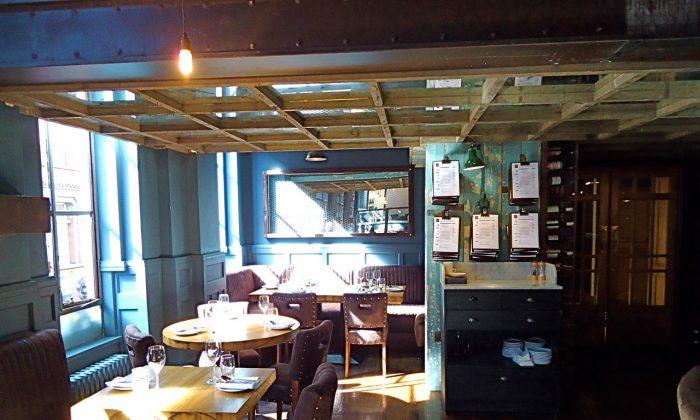Eating a slice of bread and butter in Ireland is like eating a slice nowhere else in the world. The butter is richer, the bread is fresher, and the taste is divine. From this basic food to all the permutations of Michelin-starred cuisine, Ireland is a go-to place for (food) lovers. For those who think that Irish cookery is defined by corned beef and cabbage even the smallest culinary adventure around Dublin or into the countryside can be an eye-opening and palette-exhilarating experience.
Starting in Dublin
My recent adventures in Irish cooking began at a restaurant called Cleaver East in the trendy Temple Bar district of Dublin. Cleaver East is a shabby-chic place whose minimalist décor is dominated by the silhouettes of small metal meat cleavers strung along cathedral-sized windows. Michelin-starred chef Oliver Dunne has created a fresh and innovative tasting menu that explores all the foodie possibilities of the local Irish landscape. Dunne’s concept is to present a broad selection of small tapas-like portions that can be enjoyed by one or more people.
After an informative discussion with my waiter, my meal began with black pepper and sesame-crusted seared tuna served with a sweet-corn relish, notable for the intensity of its flavor. The dish was playfully presented with squiggles of fresh herbs on top. Beef carpaccio with rocket pesto and parmesan followed by a flavorful slice of crispy lamb breast with rosemary aioli and slow-roasted tomato completed the savory dishes. Each dish contained its own unique flavor-profile and each was carefully composed and perfectly cooked. Coconut parfait with a dollop of raspberry sorbet surrounded by dots of an exquisite lime sauce finished off the meal. My helpful waiter suggested the house red wine and it worked well with the food.
County Kilkenny
Cleaver East is up-scale but I didn’t have to eat to above my budget to find brilliant food. A few hours by car down the Southeast Coast in County Kilkenny I stopped at Corcoran’s Pub, an historic watering hole that taps into Irish beer culture and local pub grub. Serving the town of New Ross since 1869, the food took advantage of produce from the surrounding countryside and traditional country cooking.
Tomato and herb soup, with the tang of the herbs punching through the sweetness of the tomato, was served with fresh brown bread and butter, off-the-vine and sun-dried tomatoes, locally cured ham, generous wedges of cheese, olives, enormous spring onions, and a home-baked apple tart.
“Are you hungry?” the proprietor asked as I came in, and in answer, I fell on the food like a starving army of one. It was from New Ross that so many starving immigrants in the 19th-century left Ireland for a new world. Walking off my gustatory indulgences later on the deck of the Dunbrody Famine Ship anchored at the quay nearby allowed me time to appreciate the economic and culinary resurgence of modern Ireland.
An hour or so down the road at Dunbrody House, celebrity television chef Kevin Dundon and head chef Nick Davey preside over a kitchen that specializes in seasonal tasting menus focusing on seafood from Ireland’s 2000-plus miles of coastline as well as its homegrown lamb and beef. It was the food from the sea that drew me and I tried something very basic—fish and chips with a creamy homemade tartar sauce. The haddock was moist and tender sitting in a wire cone atop a mound of skinny crispy chips.
For dessert, Chef Dundon had taken fresh rhubarb from the garden and layered it into a piquant parfait, not too sour, not too sweet, and packed with flavor. Being in Ireland during the springtime rhubarb season and seeing all of the ways that different eateries use what was once a Chinese medicinal herb was a culinary adventure all on its own.
Another restaurant that has deconstructed basic Irish cooking in appetite-satisfying ways is the Café at the Bishop’s Palace in Waterford. What was once a rough and ready meal for farmers and is still one of the most popular lunches in the region, the Ploughman’s Lunch, was presented here as an impromptu picnic on a plate. A wooden platter of crisp baguettes and rich brown bread combined with an assortment of local artisanal Irish cheeses and home-cured ham set off by a carefully cooked Scotch egg, sliced apple, salad, and two types of chutney provided a picture-perfect meal. It was the freshness of the ingredients that allowed the food to shine, one of the hallmarks of Irish cooking that I found everywhere.
County Wicklow
Driving back up the coast to County Wicklow, I stopped near Ashford. It was here in 1868 that one of Ireland’s most famous gardens was planted. Nearly 150 years later, 5,000 exotic plants flourish, flower, and seed at Mt. Usher Botanic Gardens. Nestled among the greenery is the airy Avoca Garden Café whose reputation for clever twists on typical Irish dishes shares space on the menu with more exotic excursions into Italian and Moroccan cuisines.
A jug of fresh pressed lemonade on the table and a basket of Ireland’s unmatchable breads accompanied my garden salad of field greens, marinated sweet beet relish, fresh sliced beetroot, and fresh herbed goat’s cheese called crottin. Served with a house-made orange chutney, the final touch on the plate was a sprinkling of spelt, a wheat that has been cultivated since the 5th millennium B.C. and looks and tastes like a mild pine nut. A salad is more than lettuce on a plate as every Californian knows and those on the menu at the Garden Café quickly confirmed its kitchen’s understanding of the salad-making art. Dessert was equally simple but satisfying—a rhubarb and egg-rich custard crumble accompanied by a scoop of honeycomb ice cream.
Back to Dublin
I ended my culinary tour where I had begun, back in Dublin south of the River Liffey, this time eating with a friend on South William Street, a busy eating thoroughfare where restaurants dedicated to a whole variety of ethnic cuisines jostle side by side. The Eden Grill has its own gourmet approach to Ireland’s abundant array of ingredients. My dinner companion proclaimed the grilled asparagus with Bayonne ham, poached egg, and hollandaise was delicious but grew lyrical over the grilled sea bass with hazelnut butter crust, smoked potato, fennel, and orange-citrus emulsion. “The best I ever had,” was the verdict.
My cauliflower soup with its decorative swirl of olive oil and crossed bacon strips was creamy and surprisingly delicate for such a hearty vegetable. My main course was a 6-ounce strip loin served with herb butter and triple cooked chips. Festive sprigs of lightly sautéed watercress added peppery overtones to the exceptionally tender meat.
Once upon a time, Irish cooking was a dismal subject dominated by its eponymous stew, corned beef, and potato mash but the modern Irish culinary revolution has remade the landscape of the nation’s kitchens. No matter where you travel in Ireland, innovative cooking and locally sourced ingredients will provide memorable meals and keep you wanting to come back for more.
Susan James is a freelance writer based in Los Angeles. She has lived in India, the U.K., and Hawaii, and writes about travel, art, and culture.






Friends Read Free